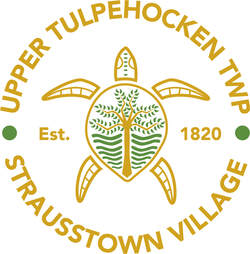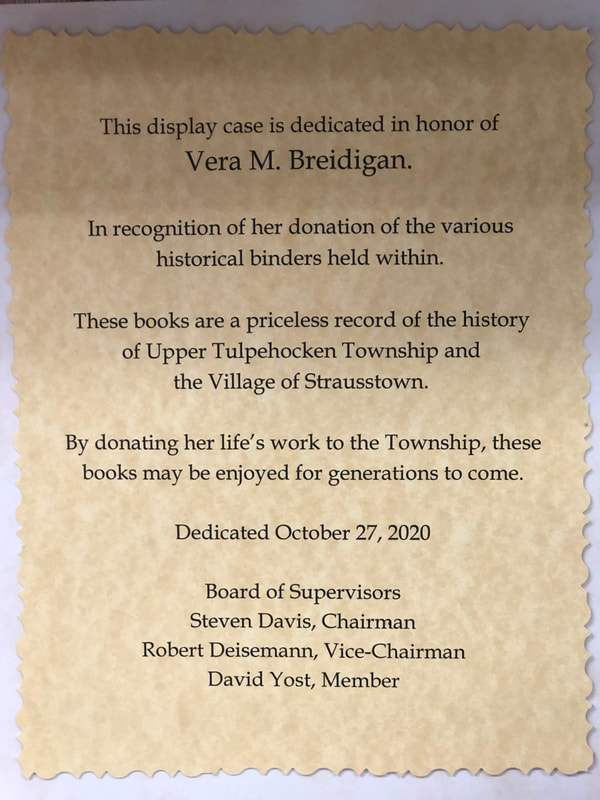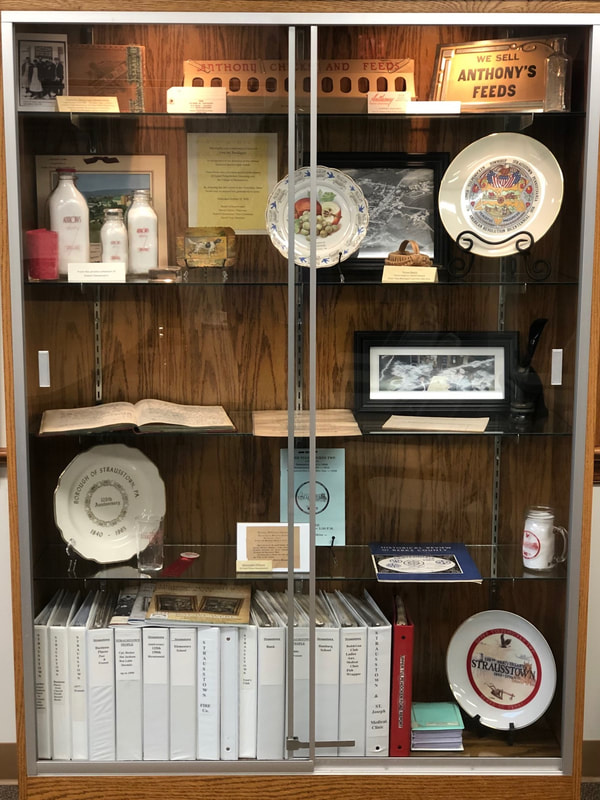History
The entire northwestern part of Berks County was once named Tulpehocken, which was organized as a district in 1729, when it was part of what was then Chester County. The area that is now known as Upper Tulpehocken Township was settled as early as 1735, but did not become a township of it own until 1820. Until that time it was part of Tulpehocken Township.
In 1820 a petition was presented to the Court to form a new township and to name that new part "Perry". This name was unsatisfactory to a large number of people, resulting in several more petitions suggesting other names. Since the Turtle Tribe of the Lenni Lenape Indians occupied the area and the name "Tulpehocken" is of Indian origin meaning "Land of the Turtle", the Court felt it was appropriate to name the new township "Upper Tulpehocken". This ended the controversy, since the location was the main deciding factor of the name.
The first designated place to vote in the newly formed township was the public house of Christian Long. Three Supervisors were elected, with each one being responsible for the care of a section assigned to him. Since the record books were passed from one Supervisor to another, with no permanent place to store them, the early records have since been lost and the names of the first three Supervisors are unavailable. Before this, the voters went to Reading, then in 1779 to the house of Godfrey Rohrer in Tulpehocken; in 1809 to the house of Henry Horst; and in 1812 part of the township went to the public house of George Shartle in Upper Bern Township.
The mills, forges and tanneries which at one time were successful are long gone, with the exception of one mill, which is located just south of Strausstown, on Route 183. This mill was operated by the Rebers between 1813-1828. William Miller then bought the mills and during his ownership the mill was destroyed by fire. Joseph Seyfert rebuilt the lower mill in 1894, the same year that William B. Anthony became the owner. In 1917 Mr. Anthony's son, George M. Anthony, started his poultry business at the same location, with 125 baby chicks. In 1926 the demand for feeds became so great, that the old flour mill was discontinued and the mill was enlarged with up-to-date equipment. The Anthony family helped pioneer the field of artificial brooding and have won many awards in the poultry industry. The mill then operated under the name "Geo. M. Anthony & Sons" until 1979, at which time Donald Anthony, third generation, became the owner and changed the name to "Anthony's Mill". In 2004 the mill was purchased outside of the Anthony family.
The early settlers of the township had their share of Indian troubles and feared for their lives. Forts were erected as places of refuge along the Blue Mountain. In charge of their erection, was no less a personage than Ben Franklin himself. The Blue Mountain is broken by five gaps of almost equal distance from one another between the Delaware and Susquehanna Rivers. Additional forts were erected between the gaps as havens for refugees. Many of them were little more than stone buildings that were adaptable for defense. One such fort situated in the township was Fort Northkill. It was built in the early part of 1754 and was about two miles east of Strausstown, near the Northkill Creek and about one mile south of the base of the Blue Mountain. It was recorded that the fort was about nine miles to the west of the Schuylkill River and stood in a very thick wooded area on a small rising ground, half a mile from the middle of the Northkill Creek. It was intended for a square about thirty-two feet each way; at each corner was a half-bastion of very little service to flank the curtains. The stockades were ill fixed in the grounds and open in many places. Within was a very poorly constructed log house for the people. It had not a chimney and could afford little shelter in bad weather. On October 1, 1757, there was an attack in the neighborhood of the fort. Application was made to Conrad Weiser at Reading, for immediate assistance. Captain Oswald, who commanded the guards around Reading, sent two lieutenants with forty men to the relief. Fort Dietrich Snyder was situated north of Strausstown and about two miles west of Fort Northkill. This fort was used as an observation post, from which burning homesteads could be seen for miles.
Bloody Spring and the Degler Chest are also part of the history of Upper Tulpehocken Township. History tells us that a family named Spatz was massacred near the spring and their blood ran into the spring, therefore naming it Bloody Spring. In the same area as the Bloody Spring, a family named Degler settled. One of the possessions which they brought with them was a chest. It was known that Mr. Degler was friendly with the local Indians, but with the French and Indian War, Indians from New York state were coming into the area and killing the settlers. Knowing this, Mr. Degler and his family took refuge at Fort Northkill. Upon returning home weeks later, they found the house ransacked and the chest broken open. The Degler family repaired the chest as best they could. It is noted in the deed to that property, that the chest shall remain with the house/property, if and when there is ever new ownership.
In 1963 the Supervisors of Upper Tulpehocken Township voted to purchase land along Old Route 22 from Marion Hicks. For many years before the township building was erected, the road equipment was housed
in a barn rented from Zion's Blue Mountain Church. The township meetings were held in public meeting houses, private homes, the Strausstown School building, and the Strausstown Fire Hall until 1980; at which time the meeting room in the township maintenance building was completed. In 2004 a new municipal
office building was constructed to house the office and new meeting room, converting the old meeting
room into a road crew work center.
Strausstown was the only town in the Township until 1920, at which time it was incorporated and became Strausstown Borough. On April 26, 2016 residents of both Upper Tulpehocken Township and Strausstown Borough voted on a referendum question to merge Strausstown Borough into Upper Tulpehocken Township, forming one 2nd Class Township effective July 1, 2016. This referendum passed overwhelmingly by 75% in Upper Tulpehocken Township and 94% in Strausstown Borough for an overall 80% approval vote.
Strausstown Village continues to be the community center of Upper Tulpehocken Township.
In 1820 a petition was presented to the Court to form a new township and to name that new part "Perry". This name was unsatisfactory to a large number of people, resulting in several more petitions suggesting other names. Since the Turtle Tribe of the Lenni Lenape Indians occupied the area and the name "Tulpehocken" is of Indian origin meaning "Land of the Turtle", the Court felt it was appropriate to name the new township "Upper Tulpehocken". This ended the controversy, since the location was the main deciding factor of the name.
The first designated place to vote in the newly formed township was the public house of Christian Long. Three Supervisors were elected, with each one being responsible for the care of a section assigned to him. Since the record books were passed from one Supervisor to another, with no permanent place to store them, the early records have since been lost and the names of the first three Supervisors are unavailable. Before this, the voters went to Reading, then in 1779 to the house of Godfrey Rohrer in Tulpehocken; in 1809 to the house of Henry Horst; and in 1812 part of the township went to the public house of George Shartle in Upper Bern Township.
The mills, forges and tanneries which at one time were successful are long gone, with the exception of one mill, which is located just south of Strausstown, on Route 183. This mill was operated by the Rebers between 1813-1828. William Miller then bought the mills and during his ownership the mill was destroyed by fire. Joseph Seyfert rebuilt the lower mill in 1894, the same year that William B. Anthony became the owner. In 1917 Mr. Anthony's son, George M. Anthony, started his poultry business at the same location, with 125 baby chicks. In 1926 the demand for feeds became so great, that the old flour mill was discontinued and the mill was enlarged with up-to-date equipment. The Anthony family helped pioneer the field of artificial brooding and have won many awards in the poultry industry. The mill then operated under the name "Geo. M. Anthony & Sons" until 1979, at which time Donald Anthony, third generation, became the owner and changed the name to "Anthony's Mill". In 2004 the mill was purchased outside of the Anthony family.
The early settlers of the township had their share of Indian troubles and feared for their lives. Forts were erected as places of refuge along the Blue Mountain. In charge of their erection, was no less a personage than Ben Franklin himself. The Blue Mountain is broken by five gaps of almost equal distance from one another between the Delaware and Susquehanna Rivers. Additional forts were erected between the gaps as havens for refugees. Many of them were little more than stone buildings that were adaptable for defense. One such fort situated in the township was Fort Northkill. It was built in the early part of 1754 and was about two miles east of Strausstown, near the Northkill Creek and about one mile south of the base of the Blue Mountain. It was recorded that the fort was about nine miles to the west of the Schuylkill River and stood in a very thick wooded area on a small rising ground, half a mile from the middle of the Northkill Creek. It was intended for a square about thirty-two feet each way; at each corner was a half-bastion of very little service to flank the curtains. The stockades were ill fixed in the grounds and open in many places. Within was a very poorly constructed log house for the people. It had not a chimney and could afford little shelter in bad weather. On October 1, 1757, there was an attack in the neighborhood of the fort. Application was made to Conrad Weiser at Reading, for immediate assistance. Captain Oswald, who commanded the guards around Reading, sent two lieutenants with forty men to the relief. Fort Dietrich Snyder was situated north of Strausstown and about two miles west of Fort Northkill. This fort was used as an observation post, from which burning homesteads could be seen for miles.
Bloody Spring and the Degler Chest are also part of the history of Upper Tulpehocken Township. History tells us that a family named Spatz was massacred near the spring and their blood ran into the spring, therefore naming it Bloody Spring. In the same area as the Bloody Spring, a family named Degler settled. One of the possessions which they brought with them was a chest. It was known that Mr. Degler was friendly with the local Indians, but with the French and Indian War, Indians from New York state were coming into the area and killing the settlers. Knowing this, Mr. Degler and his family took refuge at Fort Northkill. Upon returning home weeks later, they found the house ransacked and the chest broken open. The Degler family repaired the chest as best they could. It is noted in the deed to that property, that the chest shall remain with the house/property, if and when there is ever new ownership.
In 1963 the Supervisors of Upper Tulpehocken Township voted to purchase land along Old Route 22 from Marion Hicks. For many years before the township building was erected, the road equipment was housed
in a barn rented from Zion's Blue Mountain Church. The township meetings were held in public meeting houses, private homes, the Strausstown School building, and the Strausstown Fire Hall until 1980; at which time the meeting room in the township maintenance building was completed. In 2004 a new municipal
office building was constructed to house the office and new meeting room, converting the old meeting
room into a road crew work center.
Strausstown was the only town in the Township until 1920, at which time it was incorporated and became Strausstown Borough. On April 26, 2016 residents of both Upper Tulpehocken Township and Strausstown Borough voted on a referendum question to merge Strausstown Borough into Upper Tulpehocken Township, forming one 2nd Class Township effective July 1, 2016. This referendum passed overwhelmingly by 75% in Upper Tulpehocken Township and 94% in Strausstown Borough for an overall 80% approval vote.
Strausstown Village continues to be the community center of Upper Tulpehocken Township.



